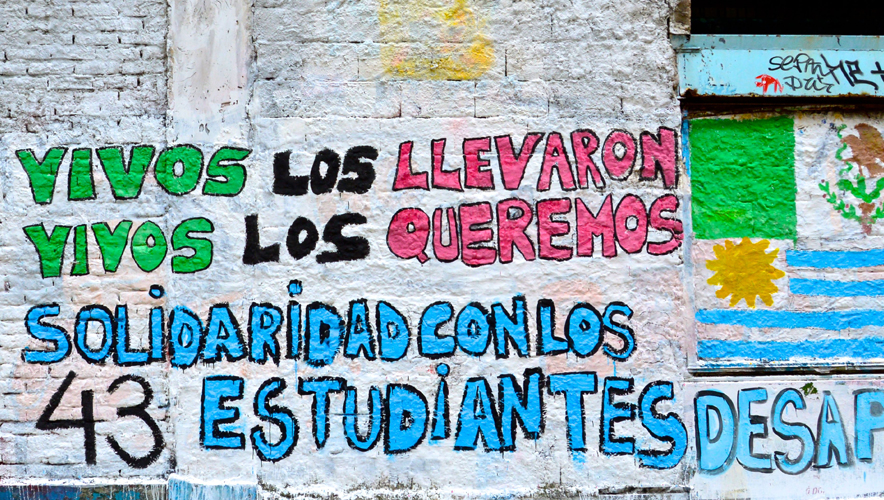Update on Safety and Security in Mexico
We are crushed to the ground;
we lie in ruins.
There is nothing but grief and suffering
In Mexico and Tlatelolco,
where once we saw beauty and valor.
This excerpt from a 16th century poem on the Spanish conquest of the Aztecs is apt today as news continues to show the tenuousness of safety and security in Mexico.
Start with the new report from the Interdisciplinary Group of Independent Experts (GIEI, based on the Spanish-language abbreviation), which is investigating the abduction and presumed killing of 43 student-teachers in Iguala, Mexico, in 2014. GIEI alleges that Mexican armed forces had, at the very least, obstructed the investigation.
Mexican armed forces knew about attack on 43 students, report says https://t.co/1koBQasSS0 pic.twitter.com/Oby4hucpAl
— Reuters (@Reuters) March 29, 2022
In September 2014, the arrest and subsequent disappearance of the group captured international attention and sparked outrage in the country. A group of students at the Ayotzinapa Rural Teachers’ College commandeered five buses to travel to a protest demonstration in Mexico City. They were stopped by state and federal police, and a chaotic scene ensued with eyewitness reports of the police shooting at the students. Approximately half of the group—43 men in total—were taken into custody and disappeared until the charred bone fragments from three of them were later found.
The official government explanation was that corrupt local police arrested the students and handed them over to a drug cartel, who concluded they were from a rival gang, killed them, and incinerated their bodies. The explanation never fit the evidence well, and protests ensued, eventually leading to the government appointing the GIEI.
The GIEI released two reports by the end of 2016, citing evidence that the official account could not have been accurate. The government of Mexican President Andrés Manuel López Obrador re-impaneled the GIEI in 2018, and yesterday’s report is the first since it was restarted. News site Laprensa Latina reported:
“In presenting its third report on Ayotzinapa, the IACHR’s Interdisciplinary Group of Independent Experts (GIEI) for the first time showed a video filmed a month after the disappearances in which members of the Mexican navy seem to be actively manipulating evidence at a waste dump where bodies of the victims were said to have been incinerated.”
The report also says the video shows the presence of then-Attorney General Jesus Murillo Karam and then-head of the Criminal Investigations Agnecy, Tomas Zeron—who is currently a fugitive from Mexico in Israel and the subject of an extradition request.
The report also presents evidence that the Navy Secretariat and the Mexican army had the students under real-time surveillance at the time of incident, a fact they attempted to conceal from investigators.
In other developments, 20 people were murdered in a mass violence attack yesterday in Las Tinajas, Michoacán, Mexico. Suspected as gang-on-gang violence, a group stole a snack food truck, drove onto a compound where an illegal cockfight was underway, and sprayed bullets into the crowd.
The incident is one of a series of attacks where gangs have attacked sites where rivals have massed, including two incidents at funerals last month at which a total of 26 people are presumed dead. And, as reported last month in a Security Management post, the gangs are not limiting themselves to guns.
The violence is not isolated to remote areas or gangs warring against each other. Yesterday, loud noises at the international airport in tourist mecca Cancun sent people running and suspended flights. What was suspected as gunfire is believed to be an innocent accident, in which someone inadvertently pushed over a large vertical signboard, which dominoed into two others, each falling with a whack.
Tourists were sent scrambling by loud bangs heard at the international airport in the Mexican resort of Cancun Monday, via AP https://t.co/9CSPgbmz3E
— Bloomberg (@business) March 28, 2022
The jumpiness is not misdirected. As reported in a February article in The New York Times:
“The headlines out of Mexico have been jarring. Two women were killed in the crossfire when rival gangs started shooting at a popular sidewalk restaurant in Tulum. Gunmen battled on a beach near Puerto Morelos as tourists scrambled into a Hyatt hotel for cover. A killer-for-hire bought a day pass to an all-inclusive resort in Playa del Carmen to carry out a hit in a poolside snack bar.”
In addition, earlier this month, the Associated Press reported on the death of Juan Carlos Muñiz. He is the seventh confirmed murder of a journalist in the country this year.
The Council on Foreign Relations (CFR) estimates there have been 150,000 deaths in Mexico due to organized criminal violence since 2006, including more than 130 candidates and politicians murdered prior to the 2018 Mexican elections. And according to an essay from a Brookings Institution expert, a small decline in homicides from 2020 to 2021 does not signify progress.
“The decline in homicides is welcome. But the size of the decline is just noise in the tempo of Mexico’s criminal violence,” Vanda Felbab-Brown wrote. “The reduction is not fundamentally due to improved security policies. Mexico’s law-enforcement forces still lack incapacitation and deterrence capacities. Brazen homicides persist at unacceptable levels. Their ebb and flow largely reflect choices and tit-for-tat responses by criminal groups toward one another. …
“The Mexican government’s response remains deeply troubling—mostly a hope the criminals will sort it out among themselves. Whether in high-value targeting, countering violence and criminality in natural resources, or suppressing robberies and extortion, Mexico’s various military and law enforcement forces are instructed to only undertake operations without the visible use of force — even when criminal militias take over new territories and declare autonomy, or cartels bomb local populations.”
